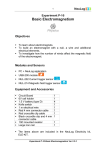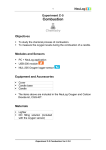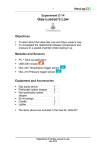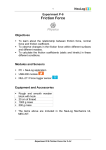Download Experiment P-46, Simple Pendulum
Transcript
1 Experiment P-46 Simple Pendulum Objectives To learn about the period and frequency of a simple pendulum. To understand the difference between a simple pendulum and a real life pendulum. To examine the effects of length and mass on the pendulum's period. Modules and Sensors PC + NeuLog application USB-200 module NUL-226 Rotary motion logger sensor Equipment and Accessories Utility stand Right angle clamp Extension clamp 35 cm thread 10 g slotted mass 1 1 1 1 2 The items above are included in the NeuLog Mechanics kit, MEC-KIT. Experiment P-46 Simple Pendulum Ver 3.0.1 2 Introduction A simple pendulum is a hypothetical apparatus consisting of a point mass hanged on a thread. The thread's mass is negligible and it is free to vibrate without friction. The motion of the hanged mass is harmonic, it swings back and forth at a constant amplitude. This is true as long as the angle from the original position is small. The amplitude of a real life pendulum swing declines over time because it is subjected to friction. A pendulum's period is the time it takes to the hanged mass to swing back and forth. The period of a simple pendulum depends on the length of the thread and the gravitational acceleration (g); not on the mass of the pendulum. A pendulum with a long thread has a greater period than one with a shorter thread. The period and the frequency (1/period) are independent of the initial angular position (for small swings). The following equations describe the period (T) and the frequency (f) of a simple pendulum: √ √ In this experiment, we will measure the angular position over time of a swinging hanged mass connected to a rotary motion sensor through a thread. Different lengths and different masses will be examined, and the expected period will be compared with the measured period. Experiment P-46 Simple Pendulum Ver 3.0.1 3 Procedure Experiment setup 1. Set up the experiment as shown in the picture below. 2. Tie one end of the thread to the 10 g mass and the other end to the rotary motion sensor. The length of the thread should be 25 cm (including the part between the thread and the rotary sensor axis) as in the picture below. Experiment P-46 Simple Pendulum Ver 3.0.1 4 Sensor setup 3. Connect the USB-200 module to the PC. 4. Check that the rotary motion logger sensor to the USB-200 module. is connected Note: The following software functions are explained in short. It is recommended to practice the NeuLog application functions (as described in the user manual) beforehand. 5. Run the NeuLog application and check that the rotary motion sensor is identified. Experiment P-46 Simple Pendulum Ver 3.0.1 5 Settings 6. Click on the On-line Experiment icon main icon bar. 7. Click on the Sensor's Module box. 8. Click on the Range button. 9. Select the Angle button to change the sensor's mode. 10. Click on the Experiment Setup icon Experiment duration to 3 minutes Sampling rate to 50 per second Experiment P-46 Simple Pendulum Ver 3.0.1 in the NeuLog and set the: 6 Testing and measurements 11. Before starting the experiment, fill in the "Expected period [s]" column in the table below (use the simple pendulum equation). Thread length Hanged mass Expected [m] [g] period [s] 0.25 10 0.2 10 0.2 20 Measured period [s] 12. Hold the 10 g mass about 60 degrees to the right of the starting position (in which the weight is hanging down). 13. Click on the Reset button, on the Sensor's Module box menu. 14. Move the 10 g mass towards the ground checking that the numbers increase but they are not higher than 300°. If they are higher than 300°, reset the sensor from the other side and check again. 15. Hold the 10 g mass about 30 degrees to the right of the starting position again (make sure the angle is around 30°). Let go of the 10 g mass and click on the Run Experiment 16. icon to start the measurement. Experiment P-46 Simple Pendulum Ver 3.0.1 7 17. At the end of the measurement, click on the Zoom fit icon . 18. Your graph should be similar to the following: 19. Save your graph. 20. Click on the Select Zone icon graph as in the picture below. 21. Click on the Show Functions icon , and then click on the rotary motion button on the left of the screen. and select a part of the Experiment P-46 Simple Pendulum Ver 3.0.1 8 Look at the frequency calculation. The frequency units are Hz, which is defined as the number of cycles per second. 22. Click on the Select Zone icon and select a different part of the graph. Click on the rotary motion button on the left of the screen. Is the frequency calculation any different than before? 23. Click on the Select Zone icon and select the first part of the graph, before the oscillations become very small towards the end. 24. Click on the rotary motion button on the left of the screen. 25. We can see that in the sample experiment the frequency is 1.001 Hz = 1.001 cycles/second. The period (of one cycle) = 1/1.001 second = 0.99 second (~1 second) 26. Calculate the period according to the example above and fill the "Measured period [s]" column with your answer. 27. Set up the 10 g mass on a 20 cm thread and repeat the experiment. 28. Set up two 10 g masses on a 20 cm thread and repeat the experiment. Experiment P-46 Simple Pendulum Ver 3.0.1 9 Summary questions 1. Did the length of the thread affect the period? How? 2. Did the hanged mass affect the period? How? 3. Was the measured period any different from the expected period? If there was a difference, what could be the cause? 4. Which factor caused the mass to stop swinging? 5. According to your results, suggest an application for a pendulum and explain. Experiment P-46 Simple Pendulum Ver 3.0.1














